Sandia researchers win best paper award for review of how rubber ages
The space shuttle Challenger blew up in 1986 because a rubber O-ring froze in the solid rocket booster. It may have shattered like an old rubber band, or at least it became too stiff to provide an air-tight seal, which released the pressurized burning gas from the rocket booster.
Picking the right rubber for the job and determining how long it will last are the specialties of Sandia materials scientists Mat Celina and Robert Bernstein (both 1853). Their comprehensive review — co-authored with Ken Gillen, now retired — garnered the award for the best paper last fall from the American Chemical Society Rubber Division.
Understanding how rubber materials perform at a fundamental level is critical in selecting the right material for the job, says Mat. Applications run the gamut from car tires and timing belts to waterproof sealants for flat New Mexico roofs, seals around solar panels to keep out moisture, nuclear power plant cable insulation, or O-rings in space shuttles and nuclear weapons.
Rubber ages due to the reaction between atmospheric oxygen and the elastic polymer. First the oxygen has to diffuse into the material, which is a physical process. Then the oxygen chemically reacts with the polymer. For more than 30 years, Sandia’s strength has been understanding both processes and combining them into a reactive diffusion model, says Mat.
Ken and fellow retiree Roger Clough began Sandia’s forays into developing better models and techniques for predicting the lifetime of different rubbers and elastic polymers in the late 1970s, establishing a foundation for polymer materials aging science at Sandia.
Best paper award
Ken retired from Sandia in 2004 after 30 years, but stayed involved. He was a part-time consultant helping Sandia colleagues with research strategies, talks, papers, and reports until 2015. He also continued serving as an editor for the international scientific journal Polymer Degradation and Stability until 2006. Mat was selected to replace him and served as editor from 2006 to 2011.

SANDIA RETIREE Ken Gillen (left) received the ACS best paper award for a review of rubber aging, co-authored by Ken and researchers Mat Celina and Robert Bernstein.
In 2014, Ken, Mat, and Robert submitted an invited conference paper to the 186th Technical Meeting of the American Chemical Society Rubber Division. It was selected as the best paper “for presenting the best critical analysis and broadening the basic understanding of concepts in rubber science and technology,” according to the citation. Ken accepted the award last October in Cleveland.
The best paper award is an acknowledgement of Sandia’s contributions to the study of polymer aging, says Mat. “It’s an independent validation for the quality of the work that we’re doing.”
The paper was reprinted as a review, “Challenges of Accelerated Aging Techniques for Elastomer Lifetime Predictions,” in 2015. It offered such a thorough review of 30 years of polymer aging research that it will be translated and reprinted in a German technical journal for wider dissemination.
“Ken Gillen has spent 30 years in research related to materials aging, so when he was asked to give a review paper he really went back and looked at what has been accomplished over the decades in terms of research activities in this particular area. He offered a really nice review,” says Mat.
Superior techniques
One challenge to accurately determining rubber lifetime is properly extrapolating from accelerated aging experiments. Sandia has developed specialized techniques that help predict the lifetime of a material during normal use by looking at the physical and chemical changes during high-temperature aging.
Ken, Roger, and Carlos Quintana, also retired, envisioned and built a unique instrument called a modulus profiler to test the mechanical changes during rubber aging. For some applications such as tires, developing a crusty outer edge is fine; in others such as rocket booster seals, it spells disaster. The machine pokes a slice of an aged rubber object to test the elasticity. The tip of the machine is so fine it can sample spots that are one-third the diameter of a human hair apart.
Mat also uses a technique called attenuated total reflectance infrared spectroscopy to look at the chemical changes within a rubber object after accelerated aging. Signals from distinguishing chemical structures can fade or disappear during aging. This indicates how the polymer is degraded by oxygen. How fast this happens at various temperatures can be used to predict an object’s normal lifetime.
Creating predictive aging models
Robert’s expertise is in compression stress relaxation tests, a technique for monitoring how rubber’s mechanical properties change under continuous pressure. Comparing the compression stress relaxation results with the chemical changes allows the researchers to match damage due to oxidation with changes to the mechanical properties, a key capability needed to create predictive aging models.
Sandia’s experimental expertise with polymers complements its decades of success in applied modeling. Ken, Mat, and Roger over the years have combined experimental data with a diffusion-limited oxidation model to improve predictions of rubber lifetimes. This modeling is especially useful if the chemical reaction pathways change at higher temperatures, and also show important distinctions between surface and bulk aging.
“Investment in fundamental materials science research, which includes a linkage between experimental and computational approaches to address complex problems in materials science, is essential to maintaining scientific leadership at Sandia. Receiving an external competitive award for our work is an indirect validation that tax dollars have been well invested. We also received this award for our passionate dedication to R&D over the past decades,” says Mat.